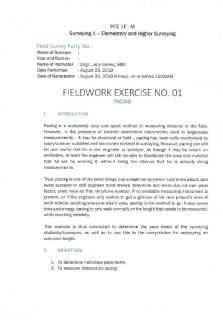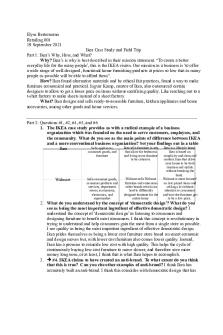Field trip Report - Browns plain waste and recycling facility PDF

| Title | Field trip Report - Browns plain waste and recycling facility |
|---|---|
| Course | Environmental Resource Management |
| Institution | Queensland University of Technology |
| Pages | 5 |
| File Size | 182.9 KB |
| File Type | |
| Total Downloads | 17 |
| Total Views | 166 |
Summary
Browns plain waste and recycling facility ...
Description
Brown Plains Waste & Recycling Facility Part A: The Facility I. Waste Flow Diagram
Service Area Weighbridge e-waste,tyres,whitegoods, battery,organics,wood, metals
paint
Leftover, non-recyclables
Market Landfill
Role Materials weighed and charged accordingly Whitegoods degassed Value add for metals; materials stripped and segregated materials are sold Useable items put in the market Packaging and paint liquids separated Paint is treated Containers are recycled Paint used as energy source Dumped into large container Compressed to save space Weighed and then taken to landfill Materials/items sold for profit Waste dumped on liner placed on top of clay soil with low permeability to avoid waste penetrating the soil below. Leachate removal pipes Methane produces used for energy Groundwater is monitored for any contamination
II. Geometric and Environmental Characteristics A weighbridge will ensure all entering vehicles are recorded and waste is monitored and charged accordingly, this way the facility has full control over the incoming traffic. Providing a general transfer station mitigates public traffic to the tipping area. This will eliminate public and commercial vehicles from mixing and also reduce any safety risks. The station also ensures waste is accurately categorized and everything that can be recycled is recycled and reduce waste going into the landfill. A disposal area is included at the end of transfer station for any waste that is leftover and can’t be recycled. This waste is then transported to landfill by facility and not the public. Waste placement and compaction: The tipping area for all the leftover waste is elevated and kept small and goes straight into a storage container than can be easily compacted and transported. Compaction is vital in ensuring the efficiency in speed to the landfill and using minimal space. Market is kept to one side of the facility and is accessible without having to go through the facility in order to save time and reduce traffic. Leachate and groundwater: The landfill is designed in a strategic way where contamination of groundwater is minimised and leachate is controlled. Clay is placed in bottom of the landfill due to its low permeability and any leachate or contaminated water that reaches here is not able to contaminate the natural soil or natural water level. A liner is placed on top of this to slow the seepage of leachate and contain landfill gas. IT is ensured the chosen liner material is strong enough to withstand the weight of the waste and resistant to punctures and degradation. There are pipes (black and yellow coloured) that collect the gas from the bottom with slight suction. The gas collected is then used to produce energy. The suction of the pipe is controlled and sometimes reduced in order to maintain moisture. Stormwater management; A stormwater basin is put in place at the facility to contain rainfall. Waste cover is used to also manage the stormwater. The landfill is covered with good soil and grass which contributes to managing stormwater and not allowing the water to penetrate deep into landfill. Odour and dust management; The waste cover mentioned above contributes to reducing the odour. Deodorizing pipes are placed throughout the landfill that spray fine mists which is carried by the wind and contribute to reducing odour. The waste is also dumped in a way which exposed surface area is reduced minimising wildlife coming into contact with waste. Water is extracted from the basin and a truck drives around spraying mist to reduce the dust in the area.
Part B: Potential Improvements III. Areas of profit/increasing sustainability Food Waste: Build rapport with local restaurants and food businesses. Providing them with a drop off zone for their organic and food wastes. By providing clear instructions on allowed waste and method of disposal large amount of waste can be saved from going to the landfill. Nutrient rich waste is collected and monitored for any contaminations and then processed in the facility. The waste can be turned into compost as well as liquid fertiliser. A process can be designed in which the waste is dehydrated and condensed, this will produce solid compost and either liquid compost or excess grey water that can be used for other outdoors purposes. The by products of this method will drive local businesses to be more sustainable and build a relationship with the recycling facility. By diverting this waste from the landfill, the amount of leachate and methane production is decreased and also provides an avenue to make profit. Manure: Another section can be added at the transfer station for any local farmers or people with farm animals so they can drop off manure. The collected manure can then be aged (as fresh manure isn’t good for plants) and can be sold at the market. This process can save farmers money in disposing their farm wastes and contributing to landfill waste. This add another product that can be sold at the market in large quantities and acquire profit
IV. Integrating New Recycling Concepts PureCycle Technologies partnered with P&G have invented a new way in which plastic can be recycled without reducing its value and create high quality products. They recycle used plastics to produce polypropylene which can then be used by companies to create new plastic products in a cheaper and much more sustainable manner. The plastic wastes are melted and dyes,odors an any other contaminants are separated using gas solvents producing good quality resin. The process unlike other recycling technologies doesn’t use large amounts of energy and avoids high cost. PureCyce first plant is expected to be able to recycle approximately 119 million pounds of polypropylene. Adopting this technology/plant in the Browns Plains facility would greatly minimise the amount of plastic that goes to landfill. An additional drop off zone can be created at the facility for public and businesses to dump their plastics. IBM has developed a new method named VolCat which can breakdown most products that aren’t usually recyclable and end up in landfill using ‘molecular sorting’ technique. One example is its ability to break down fabric that isn’t pure, such as cotton and polyester blend. The cotton is spun into a ball for reuse and polyester turned into powder. It can also handle hard plastics and transform them into powder to later be used for other plastic products. The main advantage of VolCat is its versatility and ability to recycle waste with a mix of materials using a catalytic chemical process. It would be a huge advantage for the Brown Plains
recycling facility to implement this method at the section of transfer station where public dumps all the leftover non-recyclables. Ektarinburg and Tyumen scientists have found a way to co-coking organic municipal solid waste and tar from oil refineries. This advanced technology converts waste into energy in liquid forms like gasoline,diesel and bitumen. Most common methods of producing these essential liquids produce large amounts of greenhouse gases and also use a lot of energy. Cocoking wastes to produce petroleum products doesn’t require any external energy as the needed power is sourced from the gas burning during the coking process. It also avoids any gas emissions make it a cost effective and highly sustainable method. By collecting organic wastes from the Brown Plains facility and providing a waste source to this sort of technology the facility can considerably decrease the amount of waste going to landfill.
References Enterprise, W. (2019, March 13). PureCycle Technologies Partners with Milliken, Nestlé to Accelerate Revolutionary Plastics Recycling. Retrieved from https://www.globenewswire.com/news-release/2019/03/13/1752436/0/en/PureCycleTechnologies-Partners-with-Milliken-Nestlé-to-Accelerate-Revolutionary-PlasticsRecycling.html Goldsberry, C. (2019, February 14). IBM's VolCat process uses 'molecular sorting' to turn mixed-waste recyclate into virgin-grade PET. Retrieved from https://www.plasticstoday.com/recycling/ibm-s-volcat-process-uses-molecular-sorting-turnmixed-waste-recyclate-virgin-grade-pet/78573423860251 (2019, January 29). Headquarters of BRICS Network University can be located at the university. Retrieved from https://urfu.ru/en/news/26025/ Hirsh, S. (2019, February 20). This new system could change how we recycle. Retrieved from https://www.weforum.org/agenda/2019/02/ibm-develops-innovative-recycling-systemfor-fabric-dirty-plastic-bottles-and-more/ (2019). Home. Retrieved from https://purecycletech.com/ (2019, March 13). PureCycle Technologies. Retrieved from https://www.pressreleasefinder.com/PureCycle_Technologies/ Ural_Federal. (2019, January 31). Scientists develop new recycling technology. Retrieved from https://www.eurekalert.org/pub_releases/2019-01/ufu-sdn013119.php...
Similar Free PDFs

Virtual Field trip report
- 6 Pages

Field trip report
- 9 Pages

FIeld Trip Assignment
- 4 Pages

Campus Field Trip Guide F 14
- 17 Pages

Field Report
- 18 Pages

Pre Trip Report
- 10 Pages

Surveying Field Report
- 6 Pages
Popular Institutions
- Tinajero National High School - Annex
- Politeknik Caltex Riau
- Yokohama City University
- SGT University
- University of Al-Qadisiyah
- Divine Word College of Vigan
- Techniek College Rotterdam
- Universidade de Santiago
- Universiti Teknologi MARA Cawangan Johor Kampus Pasir Gudang
- Poltekkes Kemenkes Yogyakarta
- Baguio City National High School
- Colegio san marcos
- preparatoria uno
- Centro de Bachillerato Tecnológico Industrial y de Servicios No. 107
- Dalian Maritime University
- Quang Trung Secondary School
- Colegio Tecnológico en Informática
- Corporación Regional de Educación Superior
- Grupo CEDVA
- Dar Al Uloom University
- Centro de Estudios Preuniversitarios de la Universidad Nacional de Ingeniería
- 上智大学
- Aakash International School, Nuna Majara
- San Felipe Neri Catholic School
- Kang Chiao International School - New Taipei City
- Misamis Occidental National High School
- Institución Educativa Escuela Normal Juan Ladrilleros
- Kolehiyo ng Pantukan
- Batanes State College
- Instituto Continental
- Sekolah Menengah Kejuruan Kesehatan Kaltara (Tarakan)
- Colegio de La Inmaculada Concepcion - Cebu








